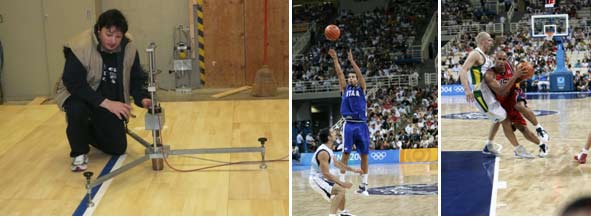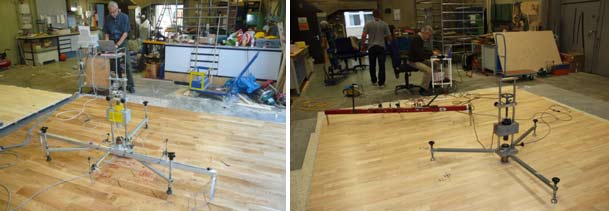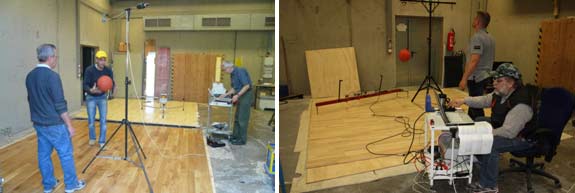UNI EN 14904 Indoor surfaces for multi-sports use
Only reference standards for sports floorings
European Standard (EN 14904:2006) was developed by the Technical Committee CEN/TC 217 "Surfaces for sports areas", whose secretariat is managed by BSI.
The European standard shall be given the status of National Italian Standard since October 2006, and all other national conflicting standards must have been withdrawn within October 2006.
The European Standard has been processed within a task assigned to CEN by the European Commission and by the European Free Trade Association, and supports the essential requirements set by the European Union Directives.
According to the CEN/CENELEC Internal Regulations, the National Standards Organizations of the following countries are bound to implement the European Standard: Austria, Belgium, Cyprus, Denmark, Estonia, Finland, France, Germany, Greece, Ireland, Iceland, Italy, Latvia, Lithuania, Luxembourg, Malta, Norway, Netherlands, Poland, Portugal, United Kingdom, Czech Republic, Romania, Slovakia, Slovenia, Spain, Sweden, Switzerland and Hungary.
Sports surfaces go through a complex reaction when subjected to dynamic loading.
The desired components of the interaction are deformation under load, ability to absorb impact, and energy return of the impact, for instance the amount of energy returned to a sportsman from the surface on which he/she is playing. The power of a surface to absorb an impact is an important safety feature. The specified values are therefore a necessary compromise between these essential features. Sports surfaces react differently under different temperatures and strain rates; they get harder at low temperatures and softer at high temperatures.
An important requirement for safety and sports performance is for there to be enough grip between the athlete’s footwear and the sports surface. Inadequate grip can cause the athlete slipping on the surface; too much grip can put unacceptable stress on joints and muscle ligaments.
Here are the key points of this Standard, obviously going back to the former German Standard DIN 18032, which can be appointed as the source of the current EN Standard for indoor surfaces.
Friction EN 13036-4
When tested by the method described in EN 13036-4, using CEN rubber under
dry conditions at a temperature of (23 ± 2) °C, the mean of the pendulum test value shall be between
80 e 110 and no individual test result shall differ from the mean by more than 4 units.
Shock absorption EN 14808
When tested by the method described in EN 14808, carrying out a minimum of four tests plus one test for every 500 m2 of area, the mean force reduction shall be between 25% and 75% and no individual result shall differ from the mean by more than ±5 units.
 Vertical deformation EN 14809
Vertical deformation EN 14809
When tested by the method described in EN 14809, the vertical deformation shall not exceed 5,0 mm.
Note 1: These values are laboratory values. Measurements on site may be carried out at different temperatures and humidities depending on the ambient conditions of the sport hall, in which case the surface temperature and relative humidity should be recorded in the test report.
Note 2: Information on typical shock absorption and vertical deformation values foe elastic floors is given in Annex B.
 Vertical ball behavior EN 12235
Vertical ball behavior EN 12235
When tested by the method described in EN 12235 using a basketball, carrying out a minimum of four tests plus one test for every 500 m2 of area, the mean relative rebound height shall be ±90% of the rebound height on concrete and no individual result shall differ from the mean by more than ± 3 units.
 Resistance to rolling load EN 1569
Resistance to rolling load EN 1569
Note: This property is important to ensure that the surface will not be damaged by equipment or seating that might be moved around.
When tested by the method described in EN 1569, the minimum resistance shall be 1 500 N, the maximum indentation shall be 0,5 mm under a 300 mm straight edge and no perceivable damage shall be observed after the test.
 Resistance to wear EN ISO 5470-1
Resistance to wear EN ISO 5470-1
Note: This property is important to ensure a reasonable expected lifetime in use, particularly for high usage areas (e.g. areas in front of goal on ball pitches) which tend to lose material by abrasion.
For synthetic surfaces, when tested by the method described in EN ISO 5470-1, using H18 wheels with a 1 kg load, the maximum loss in mass per 1 000 cycles shall be 1.000 mg.
For coatings and lacquers intended to be applied as part of scheduled maintenance, when tested by the method described in EN ISO 5470-1, using CS10 wheels with a 500 g load, the maximum loss in mass per 1.000 cycles shall be 80 mg.
 EN 13501-1 FIRE CLASSIFICATION OF BUILDING ELEMENTS
EN 13501-1 FIRE CLASSIFICATION OF BUILDING ELEMENTS
The new standard replaces all the former ones and sets the classification of the building materials according to the European standards.
Italy acknowledged the European Standard mainly with two Decrees. The Italian Ministry of Interior, with the Decree 15th March 2005 “Requirements of fire reaction for building elements supplied within activities regulated by specific technical fire prevention dispositions according to the European classification system” and the following Decree 16th February 2009, making changes and integrations.
For sports floorings with stay of public on the surface, the table sets the classes (A2FL-s1), (A2FL-s2), (BFL-s1), (BFL-s2), (CFL-s1), equalized to the previous Italian “Class 1”.
For floorings the reference tests are:
EN ISO 9239 Fire reaction tests on floorings
EN 11925-2 sets the flame attack on the surface
EN 9239-1 Smoke critical flux evaluation
Being this a serious and important issue, please feel free to
contact us for all details

 Vertical deformation EN 14809
Vertical deformation EN 14809 Vertical ball behavior EN 12235
Vertical ball behavior EN 12235 Resistance to rolling load EN 1569
Resistance to rolling load EN 1569 Resistance to wear EN ISO 5470-1
Resistance to wear EN ISO 5470-1 EN 13501-1 FIRE CLASSIFICATION OF BUILDING ELEMENTS
EN 13501-1 FIRE CLASSIFICATION OF BUILDING ELEMENTS